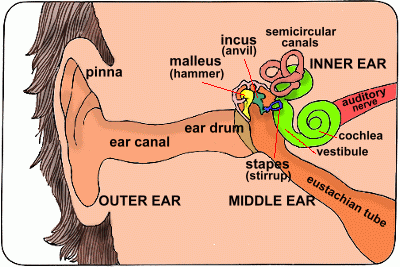  Sound is a vibration. When something makes a noise it is vibrating, and this causes air molecules around it to vibrate too. These vibrations are transmitted through the air, to our ears, where we perceive them as sound.
Sound is a vibration. When something makes a noise it is vibrating, and this causes air molecules around it to vibrate too. These vibrations are transmitted through the air, to our ears, where we perceive them as sound. You can actually see the effect of sound vibrations with an easy experiment. Get a bowl and cover the top with plastic sandwich wrap. Pull the plastic tight across the top in all directions until it is flat and smooth; tape it tight if necessary. Then sprinkle some salt onto the plastic. Now get a pot and spoon; hold them near the bowl and hit the bottom of the pot hard with the spoon. You should see the salt jump on the plastic. Try yelling loudly next to the bowl, and you may be able to make the salt jump using the vibrations from your voice. The loud noise you make is a vibration, which is transmitted through the air, to your ear and also to the plastic. The plastic vibrates, and makes the salt crystals jump! Let's examine how sounds from a vibrating object turn into sound you hear.  How Sound is Made:
How Sound is Made:When something vibrates, it moves back and forth. A vibrating object could be a speaker on a CD player, or your vocal cords, or the string on a guitar. As the object vibrates, it pushes the air molecules next to it closer together, in patterns corresponding to the movements of the object. These patterns of compressed air molecules bump into the ones next to them, passing on the pattern. In this way the original pattern of vibrations is sent through the air, as molecules continue to bump into their neighbours. Because the vibrations must push against something to send the pattern onwards, sound vibrations must travel through something in order to be heard. Sound will travel through air, and even faster through liquids and solids (where the particles are closer together). But sound can't travel where there are no particles ... so sound can't travel in a vacuum. There are no sounds in outer space, or on the moon! Sound waves are longitudinal waves because particles of the substance through which the sound passes vibrate in the same direction as the direction in which the sound moves. 
How Sound is Heard: The pattern of compressed air molecules eventually bumps into the air molecules inside your ear, next to your eardrum. When these in turn bump into the eardrum itself, they cause it to vibrate with the same pattern. The sound pattern that was originally caused by a vibrating object has now made its way into your head. Let's look at what happens next!  Your eardrum is vibrating with the same frequency as the original sound. This vibration pattern is sent into the middle ear, where it is passed on by three small bones called the malleus, incus, and stapes. (You may be more familiar with them as the 'hammer', 'anvil', and 'stirrup'). You can see an actual photo of them here.
Your eardrum is vibrating with the same frequency as the original sound. This vibration pattern is sent into the middle ear, where it is passed on by three small bones called the malleus, incus, and stapes. (You may be more familiar with them as the 'hammer', 'anvil', and 'stirrup'). You can see an actual photo of them here.
These bones act as levers, magnifying the sound energy up to 15 times. The stirrup bone (stapes) sends the sound pulses through a window in the vestibule, the upper region of the cochlea. This snail-shaped organ in the inner ear contains fluid, and its inner surface is lined with over 20,000 hair-like nerve cells. Different hairs are sensitive to particular frequencies of sound; as the energy pulses pass through the fluid and past the hairs, they vibrate with their particular frequency and send an electrical pulse along the auditory nerve, to the brain. The brain recognizes these electrical signals as sound. Other Parts of the Ear: The middle ear is a cavity which is filled with air, and is is connected by the Eustachian tube to the throat. This connection allows you to equalize the pressure in various parts of the ear. When this tube becomes clogged (when you have a cold), the ear cavity is unable to equalize the pressure; this often leads to earaches. The semicircular canals, like the cochlea, are also filled with a water-like fluid. This fluid, as it sloshes back and forth across nerve cells inside the semicircular canals, acts like an accelerometer; it helps you keep track of how your body is moving, and helps you maintain your balance. How Loud are Sounds? Sound levels are measured in decibels (dB), which are a logarithmic measure of the loudness of a sound. The quietest sound that we can actually hear is about zero decibels. The loudest sounds we hear (without pain) are about 120 dB. The loudest sounds we can hear without causing us pain have about one million times more energy than the quietest sounds we can hear. Most sounds we hear are in the range of 30 to 100 dB. Here is a table showing the decibel level of some common sounds:
Howler monkeys of South America are the noisiest land animals in the world. Their calls, which are sort of like a cross between a dog's bark and a donkey's bray, can be heard clearly for up to 5 kilometres away. The blue whale is the loudest animal on Earth. This endangered mammal is also the largest animal that ever lived; it is larger than any of the giant dinosaurs were. Blue whales mostly emit very loud, repetitive low-frequency rumbling sounds that can travel for many hundreds of kilometres underwater. These songs may be used for communicating with other blue whales, or to attract mates. You can hear a short sound clip of a single blue whale call here. The loudest sound ever made on earth was probably the sound of the meteorite that crashed on earth about 65 million years ago, perhaps killing off the dinosaurs. Using Sound for Other Things:  Sounds can also be used to do useful jobs. Man-made sound waves which are sent out by a machine can also be detected by other machines; the changes made in the sound waves as they pass through certain materials can tell us something about those materials. For example, sound waves sent into the womb of a pregnant woman will be deflected in patterns representing the outline of the fetus within. Sounds can also be used to do useful jobs. Man-made sound waves which are sent out by a machine can also be detected by other machines; the changes made in the sound waves as they pass through certain materials can tell us something about those materials. For example, sound waves sent into the womb of a pregnant woman will be deflected in patterns representing the outline of the fetus within.Similarly, vibrations sent into the earth (1) by a seismic vehicle (at right) will reflect off layers in the ground beneath, revealing something about the makeup of those layers when they are detected by arrays of geophones (2) and analyzed. The composition of these layers can lead to the discovery of oil or natural gas pockets. |